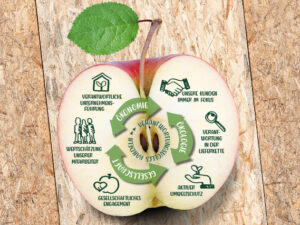If you look at the trends in sustainability reporting, you will see that two main developments determine its characteristics. On the one hand, sustainability reports are becoming more digital and interactive, giving users faster and more effective access to up-to-date information, and above all, significantly more interaction with the reporting company. At the same time, we see an increased trend towards integrated or combined reports, especially among large companies. And thus an increasing convergence of sustainability and annual reports.
Orientation to financial reporting
While this “streamlining” of reporting reflects the necessary integrated view of business goals and processes, in most cases it has not yet been subjected to a uniform standard. Instead, in most reports, one can see that the handwriting and approach to the non-financial report is increasingly aligned with the character of the business report. This is a pity and a focus on the (predominantly institutional) target groups of financial reporting gives away important communication and trust potentials with other classic stakeholders of sustainability reporting. Much of what has emerged here in recent years may be fun for the auditors and analysts who are also involved. But such dry facts no longer offer other target groups a true-to-life insight into the everyday business of sustainability-oriented action.
Those who want to raise the profile of their sustainability performance among business partners, NGOs, their own employees, or even customers should, for the time being, rely on a separate sustainability report. But even with these, a recognizable formalization of reporting practice is emerging. More than 80 percent of the reports are based on leading reporting standards and undoubtedly contribute to the desired comparability. Unnoticed by the (specialist) public, however, communicative qualities are in danger of being increasingly leveled. Corporate culture, employee identification themes, images of people, visualizations of contexts and data, and finally stories that can transform sustainability from abstraction into a real experience have become scarce in terms of content. The colorful diversity of sustainability is visibly giving way to the uniform gray of controllers and regulators.
apetito counters trends with a courageous alternative
Our customer apetito shows in its current sustainability reporting that it is also possible to counter such trends. With a courageous alternative that doesn’t weaken the qualitative “materiality” of the reporting content. The catering specialist characterized by the values of a medium-sized family business, has not only translated its sustainability practices into a living corporate culture. It has also managed the feat of producing reporting that meets the highest international standards (Global Compact, GRI Standards, Sustainable Development Goals), while at the same time presenting them in a comprehensible and highly entertaining manner.
What has emerged here is a brilliant insight into a corporate practice that, from the procurement of raw materials through the supply chain to the “table guest,” leaves no aspect of responsibility out of the equation and yet still manages to whet the appetite for even the otherwise rather dull topics of sustainability reporting through exciting stories and successful, colorful visualizations. It is to be hoped that this approach will set a precedent and encourage many other companies in the food industry, which is still very cautious when it comes to sustainability reporting, to take a more proactive approach to this topic in their communications.
You can find out more about sustainability reporting on our Reporting topic page on our blog.


